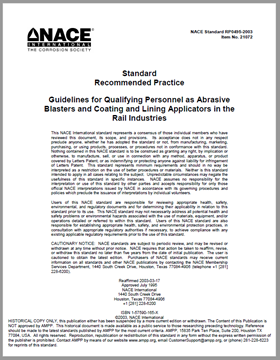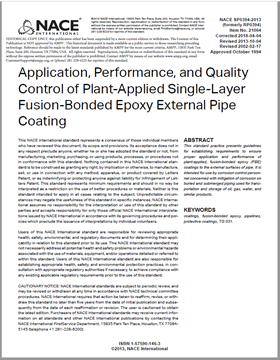This standard describes a simple test method that employs GBB equipment to remove boiler waterside deposits on a piece of tubing removed from a representative area of a boiler. Historical Document 1999
Product Number:
21236-HD1999
ISBN:
1-57590-082-3
Author:
NACE International
Publication Date:
1999
Member Price:
$179.00
Non Member Price:
$179.00
Price:
$179.00
This standard test method was developed to document the procedures used in determining the amount of deposit accumulation on a boiler tube surface, commonly expressed as the deposit-weight-density (DWD) value, via the glass-bead-blasting (GBB) technique. The GBB technique for determining DWD values is suitable for removing a wide variety of boiler deposit types, but it is especially useful when deposition is tightly adherent and would be difficult to dislodge completely via other mechanical or chemical cleaning processes (as specified in Method A and Method B of ASTM(1l D 34831), Typically, the GBB technique allows for complete deposit removal in a very short time frame, without the risk of error induced by incomplete removal of tightly adherent scale or excessive loss of the metal substrate during the cleaning process.2 This standard is for use specifically by those involved in providing technical assessments concerning boiler cleanliness, such as university/corporate research laboratories, independent research/engineering consulting firms, or those in the chemical cleaning industry. This standard is intended to be used to obtain accurate deposit-loading data, which may be pertinent to establishing the necessity of chemically cleaning boiler systems to avoid boiler tube failure incidents (such as those related to underdeposit corrosion and tube metal overheating), and to track the rate of deposit growth over time. This standard was prepared by NACE Work Group T-7H-6f, as assigned by the T-7H-6 Task Group on Failure Analysis-Boiler Waterside, which is a component of Unit Committee T-7H, Corrosion and Its Control in Steam-Generating Systems, and is published by NACE International under the auspices of Group Committee T-7 on Corrosion by Waters.
1.1 This standard describes a simple test method that employs GBB equipment to remove boiler waterside deposits on a piece of tubing removed from a representative area of a boiler. The test specimens are cut from a sample tube, weighed before and after the cleaning process, and the amount of deposit per surface area is estimated by measuring the weight loss of the tube sample test piece after deposit removal via GBB and dividing by the surface area of the test piece. The DWD value that is obtained br this method is typically expressed in mg/cm2 or gift units, and is defined as the weight of the deposit per boiler tube surface area. Currently, DWD values are commonly expressed in g/ft units. Procedures for test specimen processing, dimensional analysis.
Historical Document 1999




